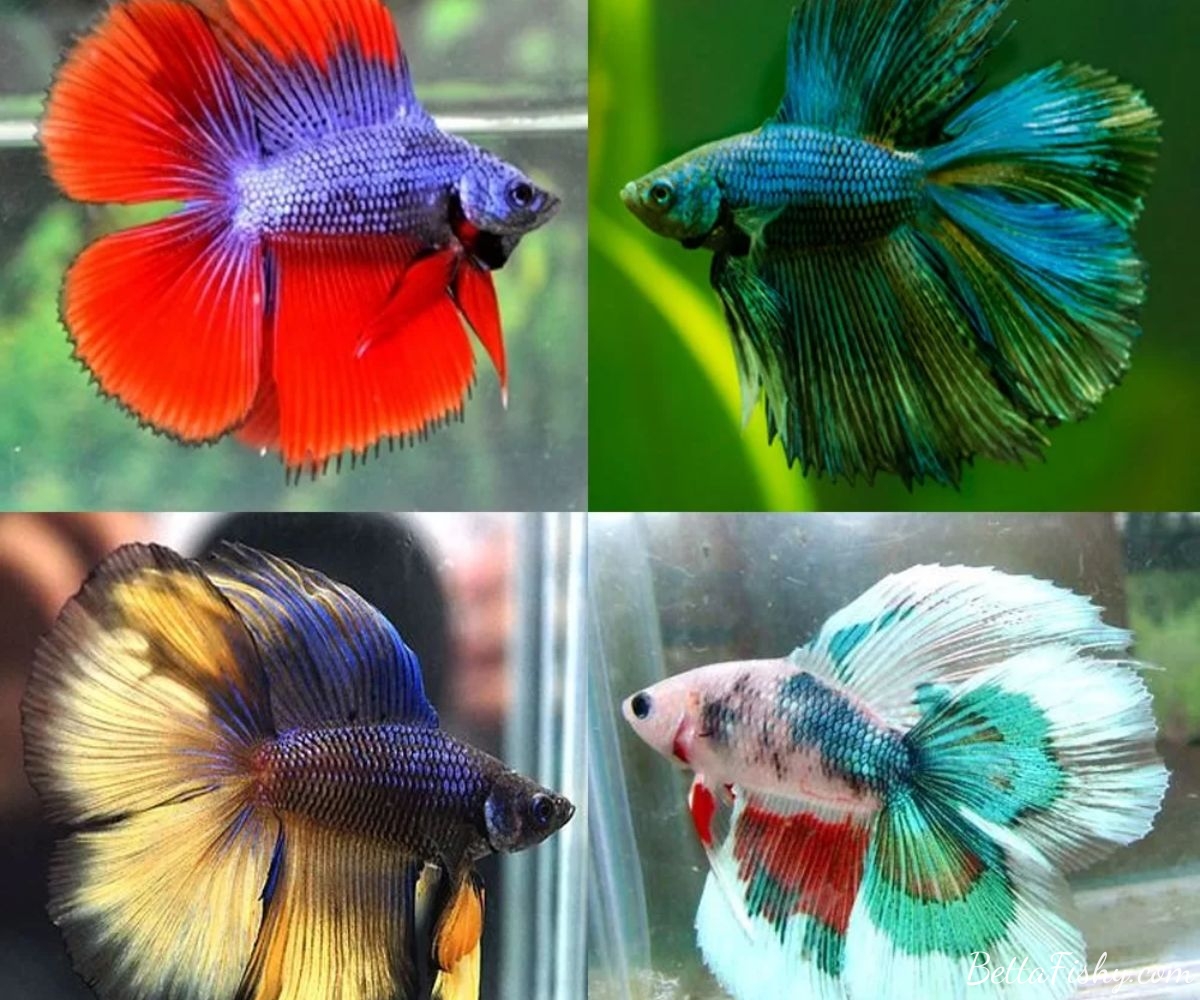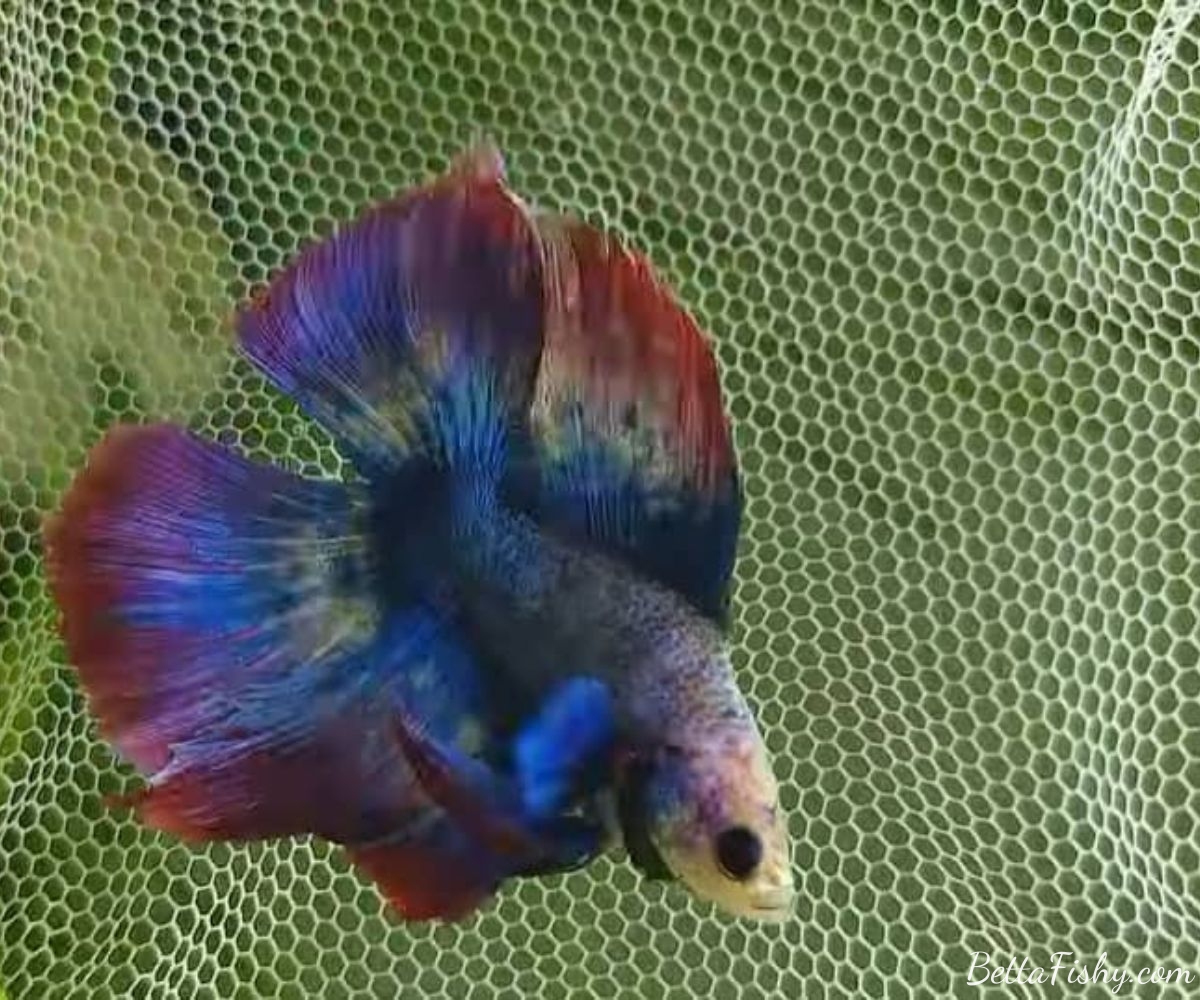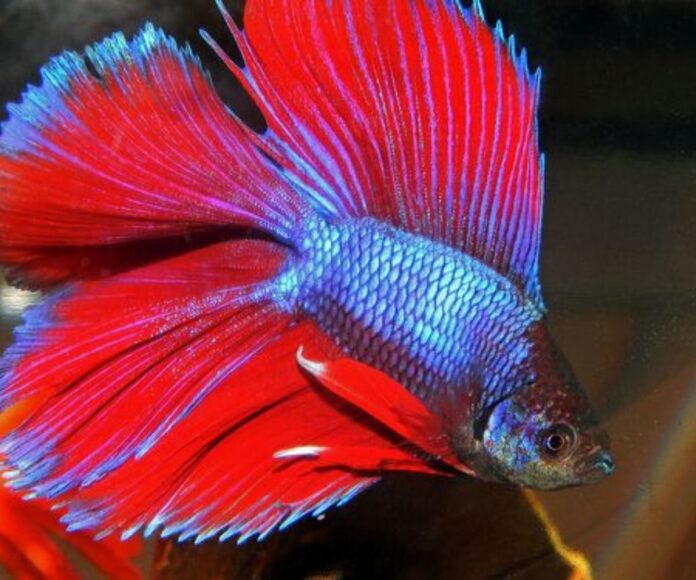Introduction
Double tail betta fish are a type of betta fish that have a genetic mutation that causes them to develop a split caudal fin, giving them two distinct tails. This mutation causes the caudal peduncle, which is the narrow part of the fish’s body before the tail starts, to shorten. This allows the caudal fin to split into two lobes, creating the double tail appearance.
The double tail betta originated as a naturally occurring mutation in betta breeding stock in Asia, particularly Thailand and Japan. Breeders initially called these fish “dumbos” because the heavy split tail made them resemble Dumbo the elephant. The double tail mutation became popular among breeders in the 1980s and 1990s when they were exhibited at aquatic shows in Europe. Since then, selective breeding has produced double tails with fuller, evenly-divided tail lobes.
While double tails were initially considered imperfect or defective fish, they are now one of the most popular types of betta among aquarium hobbyists. Their unique appearance and enlarged tail fins makes them stand out. Today there are many different double tail fin and color varieties.
Types of Double Tail Betta Fish

There are several different types and varieties of double tail bettas, which can vary in tail shape and color patterns:
Halfmoon Double Tail
The halfmoon double tail betta has a large, 180-degree fan-shaped caudal fin. This is one of the most popular double tail types due to the striking visual appearance. They are available in many different colors.
Crown Tail Double Tail
The crown tail double tail betta has distinct spiky projections extending from each ray of the caudal fin, giving it a crown-like appearance. They come in a variety of color combinations.
Plakat Double Tail
The plakat double tail betta has short, rounded fins compared to the long-finned varieties. This makes them faster swimmers. They showcase the split tail especially well.
Butterfly Double Tail
Butterfly double tails exhibit a distinct butterfly pattern on their caudal fins, featuring bands of contrasting colors radiating from the body. Common color combinations include black, red, blue, and white.
Koi Double Tail
Koi double tail bettas exhibit a variegated color pattern resembling a koi fish. They usually feature an orange-red base color with black, blue, or white splotches spread over the fins and body.
Rare Colors
Some rare color varieties of double tail bettas include green, turquoise, purple/lavender, pink, and yellow. Unique combinations like mustard gas and chocolate are also possible.
Double Tail Betta Appearance
Double tail bettas are immediately recognizable by their unique split tail fin which gives them a distinctive look. While regular bettas have a single caudal fin, double tails have a caudal fin that is clearly divided into two distinct lobes.
In double tail male bettas, the two tail lobes typically spread 180 degrees or greater when fully flared, compared to 120-160 degrees for most single-tailed varieties. This gives double tails a very full, rounded tail with a pronounced cleft down the center. The large tail fins fan out to create a striking visual effect.
Double tail females also exhibit a split caudal fin, although their fins are much shorter than males. Female double tails still retain an elegant, flowing appearance.
Both male and female double tail bettas stand out for their voluminous fins that flow and flare dramatically as they swim.
Some Tips for taking care of Double Tail Betta

Caring for a double tail betta requires paying special attention to their unique body shape and potential health issues. While double tails have the same basic care requirements as other betta varieties, their elongated body and frequent swim bladder problems require some adjustments.
Double tail bettas should be kept in at least a 5 gallon tank, though 10 gallons is better to allow lots of horizontal swimming space. The water should be maintained between 78-80°F and pH between 6.8-7.0. Perform partial water changes of 25-50% weekly.
Since double tails often struggle with swim bladder problems, keep the tank water level high with only 1-2 inches from the top. Reduce water flow and provide broad leaf plants or décor for resting spots near the surface. Feed high quality pellets and vary diet with frozen foods like brine shrimp or bloodworms.
With proper care, double tail bettas typically live 2-4 years. Monitor them closely for signs of stress or disease related to their body shape. Common issues include lethargy, loss of appetite, buoyancy problems, bloating, and fin damage from struggling to swim.
While more delicate than some betta types, double tails can thrive when given the right tank setup. Pay attention to their unique needs and they will reward you with their gorgeous fins and lively personalities.
Common diseases of Double Tail Betta
Double tail bettas are prone to some unique health issues due to their abnormal body shape. Some common health problems to look out for include:
Swim Bladder Disorder
Double tails often suffer from swim bladder problems because of their shortened body and defected tail. This can cause issues like floating, sinking, swimming on their side, or difficulty maintaining buoyancy. Make sure to feed them a high-quality diet with ingredients that support swim bladder health.
Constipation
The compact body shape also puts double tails at risk for digestive issues like constipation. Make sure their diet has enough fiber and feed daphnia to help relieve constipation when needed.
Fin Problems
The heavy double tail fins are prone to fin rot, tearing, and other damage. Keep water clean and watch for signs of infection. Use aquarium salt and betta-safe medications to treat any fin issues.
Bloating
Double tails that become constipated or have intestinal blockages may suffer from a bloated belly. Reduce feeding, fast periodically, and feed daphnia to help relive bloating.
With proper care and a healthy diet, most double tail bettas can live full lifespans. Be vigilant for signs of illness and address issues promptly to keep your fish happy.
Tips of How to Breed Double Tail Bettas
Breeding double tail bettas comes with some unique challenges compared to other betta varieties. The shortened body shape and heavy finnage of double tails can make spawning more difficult.
One challenge is that male double tails may struggle to properly wrap around females during mating embraces due to their short bodies. Breeders may need to support the pair or manually “squeeze” eggs from the female.
Double tail females also produce fewer eggs on average compared to other betta tail types. Their egg count ranges from 20-40 eggs per spawn. Breeders compensate by spawning females more frequently.
Fry and juvenile double tails require extra care as they are prone to swim bladder disorders. Keeping water levels high and feeding small, frequent meals can help.
When crossbreeding double tail bettas with other varieties, the double tail gene is dominant. Breeding a double tail with a single tail betta will result in 50% double tail offspring. Tail ratios in crosses follow predictable Mendelian genetics.
Breeding double tails for perfect 180 degree tail splits takes generations of selective breeding. The best breeding double tails have a clear 50/50 tail split and strong body form to support their heavy fins.
Tips Buying Double Tail Bettas

When looking to buy a high-quality double tail betta, it’s recommended to purchase from a reputable breeder that specializes in bettas. Some top breeders for finding beautiful double tails include Coast Gem USA and Aquatic Motiv.
When selecting a double tail betta, look for signs of health like bright colors, alertness, and active swimming. Avoid bettas that are lethargic or have clamped fins. The ideal double tail should have a clean, symmetrical split in the tail that is at least 40% of the entire tail length.
Pricing for a double tail betta can range from $10-$75+ depending on factors like age, color, tail type, and rarity. High-quality breeder double tails tend to average $20-$50. Female double tails and juveniles are usually cheaper than mature males.
With proper care, a double tail betta from a reputable source can live 2-4 years and bring you much enjoyment!
Double Tail Betta Pros and Cons
Double tail bettas have some unique advantages but also come with potential downsides to consider. On the pro side, their divided caudal fin gives them a very eye-catching, beautiful appearance that stands out from other betta varieties. The split tail comes in a vibrant array of colors and fin types, allowing for unusual and rare pattern combinations like koi and butterfly double tails.
Their striking tails make them popular among betta enthusiasts and breeders looking for an aquarium showstopper. While regular bettas have 180 degrees of caudal fin, double tails approach 360 degrees when fully flared. This exaggerated finnage has a level of elegance that draws attention.
However, the abnormal tail shape also leads to some potential drawbacks. The heavy tail fin can cause swim bladder and balance issues, making it harder for double tails to gracefully swim and rest. The range of motion in their fins may be restricted. Their long tails also make them prone to fin nipping and injury.
Additionally, double tail genetics come with an increased risk of spinal deformities. Achieving the ideal 50/50 tail split can be challenging when breeding. Overall, double tail bettas require diligent care and observation to monitor their health and wellbeing.
Double Tail Betta Fun Facts
Double tail bettas have some interesting and unique traits compared to other betta varieties:
- The first documented double tail betta was bred in 1923 by a Thai breeder named Chamnankit Sarasin.
- Double tails have the largest tail fins of any betta variety, with tail fins up to 180-degrees.
- Males typically have larger tail fins than females.
- The double tail gene is a simple recessive trait. Both parents must carry the gene for 25% of offspring to be double tails.
- Breeding double tails can be challenging due to buoyancy issues caused by their heavy tails.
- Double tail bettas with bright, bold colors and metallic scales are highly sought after by collectors and enthusiasts.
- They are also one of the most expensive betta varieties, with prize-winning show bettas selling for over $1000.
The double tail mutation makes bettas weaker swimmers but gives them a uniquely beautiful and eye-catching appearance.
Conclusion – Caring for Your Double Tail Betta
Double tail bettas are a beautiful and unique variety of betta fish. With their signature split caudal fin, they stand out in any aquarium or fish collection. However, their body shape also comes with some special care requirements. By following the tips in this guide, double tail owners can help their fish live a healthy, active life.
In summary, focus on the following when keeping double tail betta fish:
- Provide extra surface area for resting near the top
- Choose tank mates that won’t nip fins
- Feed a high-quality pelleted diet
- Maintain warm, clean water
- Quarantine new fish before introducing them
- Have an isolation tank ready in case of illness
While it takes some extra planning and care to own a double tail betta, their grace, fins, and colors make it all worthwhile. BettaFishy recommends that you do your research before bringing one home and you will be rewarded with an excellent fish that will be the star of your aquarium.


